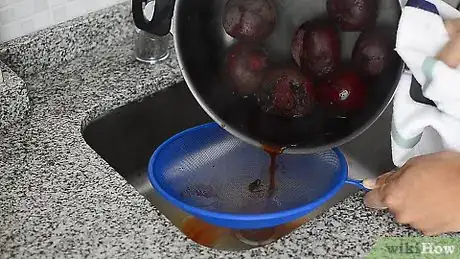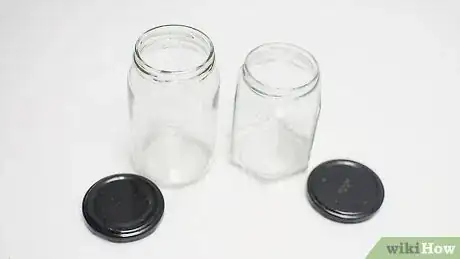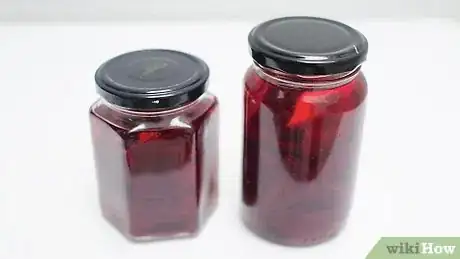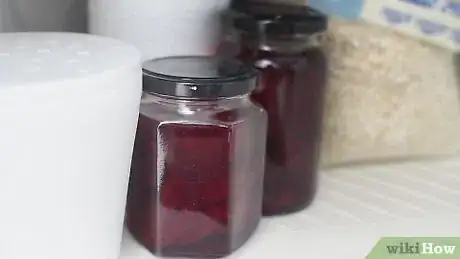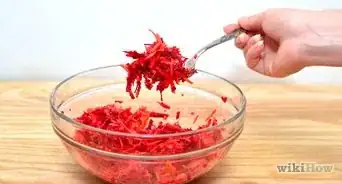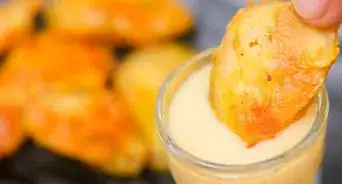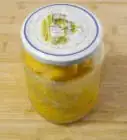This article was co-authored by wikiHow Staff. Our trained team of editors and researchers validate articles for accuracy and comprehensiveness. wikiHow's Content Management Team carefully monitors the work from our editorial staff to ensure that each article is backed by trusted research and meets our high quality standards.
The wikiHow Video Team also followed the article's instructions and verified that they work.
This article has been viewed 53,980 times.
Learn more...
Pickled beets are a fantastic addition to lots of dishes (think pickled beets, goat cheese, and arugula, or a sandwich with Italian meats, cheese, and pickled beets), and they’re also great to eat on their own! They are full of fiber, iron, and antioxidants, and they also have anti-inflammatory properties. If you find yourself with a surplus of beets and aren’t sure what to do with them, it’ll take you just an hour or so to cook, pickle, and put them into jars.
Ingredients
- 4 to 5 pounds (1.8 to 2.3 kg) of small beets
- 2 tablespoons (35 grams) of pickling salt
- 1 1/2 cups (300 grams) of granulated sugar
- 3 cups (710 mL) of white vinegar
- 2 tablespoons (12 grams) of mixed pickling spice
- 1 cup (240 mL) of water
Makes 4 US pints (0.50 US gal)
Steps
Cooking and Peeling the Beets
-
1Rinse the dirt off of the beets and trim off the tops. Gather your 4 to 5 pounds (1.8 to 2.3 kg) of small beets and rinse away any visible dirt in the sink. Use a clean cutting board and kitchen knife to trim off the tops (the leafy side). Leave about 1⁄2 inch (1.3 cm) of the stem. Throw away the rest of the tops.[1]
- There are 2 sides to a beet: the top, which is made up of the leaf and stem, and the bottom, which is where the roots protrude from.
-
2Put the beets into a pot and cover them with water. Place your rinsed and trimmed beets into a large pot, and add enough water so that the largest ones are just covered. The temperature of the water at this point doesn’t matter.[2]
- For this step, you could use a deep pot or a more shallow pan, just as long as there is enough room for the beets to be completely submerged in water.
Advertisement -
3Boil the beets until they’re tender, which will take about 25 minutes. Turn the burner to medium-high. Let the beets cook for 25 to 30 minutes, or until they can be easily pierced by a fork.[3]
- Boiling the beets will make them much easier to peel.
-
4Drain the excess water from the beets and let them cool down. Turn off the stovetop and carefully drain the water from the beets. You can either pour the entire pot into a colander, or you could also use a slotted spoon to scoop out the beets. Let them cool down enough so that you can handle them without burning your hands, which will take about 15 to 20 minutes.[4]
- If you want to speed up this process, you could submerge the cooked beets into an ice bath.
-
5Cut off the roots and slide the skins off of the beets. Use your cutting board and kitchen knife again, and slice away the roots from each beet. The skin should easily peel away from the beet. You can discard the roots and skins, or add them to a compost pile if you have one.[5]
- Beet juice can easily stain clothing, so wear clothes you don’t mind getting dirty.
-
6Slice the beets into whatever size you want for the pickling process. There is no wrong way to pickle beets—you can pickle them whole, cut them into rounds, or dice them into chunks. As you cut them, put them in a bowl off to the side of your workstation.[6]
- Since you’re making enough beets to fill several jars, you could try slicing the beets several different ways to see which you like best.
Simmering the Pickling Liquid
-
1Put your pickling spice into a cheesecloth and tie it off. You can buy pickling spice and a cheesecloth from your local grocery store. Put 2 tablespoons (12 grams) of pickling spice into the center of the cheesecloth, and twist and knot the excess fabric to seal the spice into the cloth.[7]
- Pickling spice is made up of a mixture of mustard seeds, allspice, coriander seeds, red pepper flakes, cloves, ground ginger, cinnamon, and bay leaf.
-
2Combine the vinegar, sugar, water, salt, and cheesecloth in a large pot. Use 3 cups (710 mL) of white vinegar, 1 1/2 cups (300 grams) of granulated sugar, 1 cup (240 mL) of water, and 2 tablespoons (35 grams) of pickling salt. Stir everything together, and then submerge the cheesecloth in the liquid.[8]
- For sweeter beets, substitute the same amount of white vinegar for malt vinegar.
- Make sure to use specific pickling salt for the beets rather than regular table salt. Table salt can turn the liquid cloudy because it has anti-caking ingredients in it.
-
3Bring the mixture to a boil, then simmer it for 10 minutes. Turn the heat to medium-high, and let it come to a boil. Stir the mixture every few minutes. Once it’s boiling, reduce the heat to medium and put a timer on for 10 minutes.[9]
- Keep the beets out of the simmering liquid for now—you’ll pour it over the beets later once they’ve been added to the canning jars.
-
4Remove the spice bag from the pot. Use tongs or a slotted spoon to carefully remove the cheesecloth from the pickling liquid. It’ll be really hot, so don’t try to grab it with your hands.[10]
- You can throw the cheesecloth and spice mix away, or you could rinse it out and reuse the cheesecloth again for a different project.
Canning and Pickling
-
1Clean the glass jars and lids with hot water and detergent. You can wash the jars by hand, or you could sanitize them in the dishwasher. Make sure to thoroughly rinse away all the detergent so your batch of pickled beets isn’t compromised.[11]
- Because the jars will be submerged in a hot bath and filled with hot liquid, there shouldn’t be any issue with them being disinfected.
-
2Warm your glass jars in a hot bath in the sink. Make sure your sink is clean, and plug the drain. Place your jars into the sink so they are sitting upright, and remove their lids. Fill the sink with hot water until the jars are 3/4 of the way covered.[12]
- If you don’t want to use your sink, you could also put the jars in the dishwasher and run it on the rinse cycle to heat them up.
- Heating the jars ahead of time will prevent them from potentially breaking when you later spoon in the hot pickling liquid.
-
3Divide the beets evenly between 4 pint-sized glass jars. Once the jars have been heated, use a clean spoon to distribute the beets evenly amongst them. If any beet juice gets on the sides of the jars, use a clean damp towel to clean them off.[13]
- Put the filled jars on the counter near the simmering pickling liquid so they’ll be easier to fill when the time comes.
-
4Pour the hot pickling liquid over top of the beets. Use a ladle to carefully transfer the liquid from the pot to the jars. Leave about 1⁄2 inch (1.3 cm) of space between the liquid and the top of the jar.[14]
- Be careful to not grab the side of the pot or jars with your hands, as everything will be very hot.
- Once the jars are filled, you can turn off the stove and discard of any leftover liquid.
-
5Secure the lids on the jars and store them in a cool, dry location. While the jars are still hot, put the lids on and tighten them. Put them in a cupboard or pantry, somewhere they will be away from sunlight or excessive heat.[15]
- If you find that the lids aren’t fitting tightly on the jars, switch them out for ones that do fit tightly. This helps the beets pickle properly, and it keeps them from going bad.
-
6Let the beets marinate for at least 2 weeks before you enjoy them. Put a reminder on your calendar, and wait at least 2 weeks before you crack open a jar. You can definitely let them sit for longer, even for up to 1 year.[16]
- You could give jars of beets as gifts. Create cute labels and stick them on the jars and give them away at the holidays.
-
7Store opened beets in the fridge for up to 3 months. Once you open a jar of beets, it’ll need to be stored in the fridge to help keep them good for longer. After you eat some, just make sure to refasten the lid tightly.[17]
- If you notice any mold or odd smells when you open the jar, discard the beets.
Community Q&A
-
QuestionHow long should I cook the beetroot?
 Community AnswerBeetroot can be eaten raw, so it really is a matter of taste. It also depends on how it's been prepared, but the bigger the pieces, the longer it takes.
Community AnswerBeetroot can be eaten raw, so it really is a matter of taste. It also depends on how it's been prepared, but the bigger the pieces, the longer it takes. -
QuestionWhat type of vinegar should I use for beetroot?
 Community AnswerSpicy vinegar, or you could try sweet vinegar. It helps with the final texture. Add some sriracha sauce to the vinegar, and insert the beetroots.
Community AnswerSpicy vinegar, or you could try sweet vinegar. It helps with the final texture. Add some sriracha sauce to the vinegar, and insert the beetroots.
Things You’ll Need
- Cheesecloth
- Cutting board
- Kitchen knife
- Bowl
- Saucepan or pot
- Measuring cups and spoons
- Ladle
- Glass jars with lids
- Colander
- Slotted spoon or tongs
References
- ↑ https://nchfp.uga.edu/how/can_06/pickled_beets.html
- ↑ https://nchfp.uga.edu/how/can_06/pickled_beets.html
- ↑ https://nchfp.uga.edu/how/can_06/pickled_beets.html
- ↑ https://nchfp.uga.edu/how/can_06/pickled_beets.html
- ↑ https://nchfp.uga.edu/how/can_06/pickled_beets.html
- ↑ https://nchfp.uga.edu/how/can_06/pickled_beets.html
- ↑ https://www.thekitchenmagpie.com/canned-pickled-beets-recipe/#
- ↑ https://www.thekitchenmagpie.com/canned-pickled-beets-recipe/#
- ↑ https://www.thekitchenmagpie.com/canned-pickled-beets-recipe/#
- ↑ https://www.thekitchenmagpie.com/canned-pickled-beets-recipe/#
- ↑ https://www.simplycanning.com/sterilizing-jars.html
- ↑ https://www.thekitchenmagpie.com/canned-pickled-beets-recipe/#
- ↑ https://www.bbcgoodfood.com/recipes/pickled-beetroot
- ↑ https://www.bbcgoodfood.com/recipes/pickled-beetroot
- ↑ https://www.bbcgoodfood.com/recipes/pickled-beetroot
- ↑ https://www.bbcgoodfood.com/recipes/pickled-beetroot
- ↑ https://www.stilltasty.com/fooditems/index/16519
About This Article
To pickle beetroot, start by boiling some beets and removing the roots and skin. Then, cut up the beets, or leave them whole if you'd prefer to pickle them that way. Next, tie some pickling spice in a cheesecloth and simmer it with vinegar, sugar, water, and salt for 10 minutes. Finally, put the beets in some clean glass jars, cover them with the hot pickling liquid, and store them in a cool, dry place for at least 2 weeks. To learn how to store your pickled beets after opening them, scroll down!
